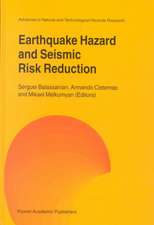Historical and Prehistorical Earthquakes in the Caucasus: Proceedings of the NATO Advanced Research Workshop on Historical and Prehistorical Earthquakes in the Caucasus Yerevan, Armenia July 11–15, 1996: NATO Science Partnership Subseries: 2, cartea 28
Editat de D. Giardini, Serguei Balassanianen Limba Engleză Hardback – 31 iul 1997
| Toate formatele și edițiile | Preț | Express |
|---|---|---|
| Paperback (1) | 1828.42 lei 6-8 săpt. | |
| SPRINGER NETHERLANDS – 6 noi 2012 | 1828.42 lei 6-8 săpt. | |
| Hardback (1) | 1834.90 lei 6-8 săpt. | |
| SPRINGER NETHERLANDS – 31 iul 1997 | 1834.90 lei 6-8 săpt. |
Din seria NATO Science Partnership Subseries: 2
- 15%
 Preț: 638.43 lei
Preț: 638.43 lei - 5%
 Preț: 1420.29 lei
Preț: 1420.29 lei -
 Preț: 390.84 lei
Preț: 390.84 lei - 18%
 Preț: 949.90 lei
Preț: 949.90 lei -
 Preț: 401.24 lei
Preț: 401.24 lei - 15%
 Preț: 653.14 lei
Preț: 653.14 lei - 5%
 Preț: 1414.64 lei
Preț: 1414.64 lei - 15%
 Preț: 642.18 lei
Preț: 642.18 lei - 18%
 Preț: 1846.40 lei
Preț: 1846.40 lei - 18%
 Preț: 949.90 lei
Preț: 949.90 lei -
 Preț: 380.07 lei
Preț: 380.07 lei - 15%
 Preț: 643.84 lei
Preț: 643.84 lei - 18%
 Preț: 1839.63 lei
Preț: 1839.63 lei -
 Preț: 416.64 lei
Preț: 416.64 lei - 18%
 Preț: 1234.77 lei
Preț: 1234.77 lei - 18%
 Preț: 950.96 lei
Preț: 950.96 lei - 15%
 Preț: 655.78 lei
Preț: 655.78 lei -
 Preț: 403.53 lei
Preț: 403.53 lei -
 Preț: 381.98 lei
Preț: 381.98 lei - 18%
 Preț: 1836.94 lei
Preț: 1836.94 lei - 15%
 Preț: 645.47 lei
Preț: 645.47 lei - 18%
 Preț: 946.87 lei
Preț: 946.87 lei - 18%
 Preț: 1227.99 lei
Preț: 1227.99 lei - 18%
 Preț: 1232.57 lei
Preț: 1232.57 lei -
 Preț: 398.15 lei
Preț: 398.15 lei - 18%
 Preț: 1232.71 lei
Preț: 1232.71 lei - 18%
 Preț: 1223.88 lei
Preț: 1223.88 lei - 18%
 Preț: 1228.77 lei
Preț: 1228.77 lei
Preț: 1834.90 lei
Preț vechi: 2237.68 lei
-18% Nou
Puncte Express: 2752
Preț estimativ în valută:
351.10€ • 367.57$ • 290.52£
351.10€ • 367.57$ • 290.52£
Carte tipărită la comandă
Livrare economică 05-19 aprilie
Preluare comenzi: 021 569.72.76
Specificații
ISBN-13: 9780792346142
ISBN-10: 0792346149
Pagini: 545
Ilustrații: XIV, 545 p.
Dimensiuni: 155 x 235 x 32 mm
Greutate: 0.97 kg
Ediția:1997
Editura: SPRINGER NETHERLANDS
Colecția Springer
Seria NATO Science Partnership Subseries: 2
Locul publicării:Dordrecht, Netherlands
ISBN-10: 0792346149
Pagini: 545
Ilustrații: XIV, 545 p.
Dimensiuni: 155 x 235 x 32 mm
Greutate: 0.97 kg
Ediția:1997
Editura: SPRINGER NETHERLANDS
Colecția Springer
Seria NATO Science Partnership Subseries: 2
Locul publicării:Dordrecht, Netherlands
Public țintă
ResearchCuprins
Seismogenesis and destructive earthquakes in the Caucasus.- Seismotectonics of the Mediterranean Region and the Caucasus.- Convergence between Eurasia and Arabia in Estern Turkey and the Caucasus.- GPS constraints on fault slip rates in the Arabia-Africa-Eurasia plate collision zone: implications for earthquake recurrence times.- Recent upper crust geodynamics of central Asia.- Seismotectonics of the Caucasus.- Seismotectonic deformation in the Caucasus.- Modern approaches in paleoseismology.- World map of active fauts, their seismic and environmental effects.- Active faults and strong earthquakes of the Armenian upland.- An investigation of some historical earthquakes and paleoseismic sources in Iran.- Catalogue of large historical earthquakes of the Caucasus.- Seismic Sources of the Trancaucasian Historical Earthquakes.- The catalogue of strong earthquakes in the territory of Armenia and adjacent Regions.- Historical Seismology Research in the Caucasus: methodological aspects and some resuls.- Building up a parametric earthquake catalogue in Europe: the historical bachground.- Strong historical earthquakes in the Armenian upland: new data and elaboration of a technique.- Analysing and improving supporting data set of the Akhalkalak, December 31, 1899, earthquake.- Recent great earthquakes of the Caucasus Region.- A regional instrumental earthquake catalogue for the Caucasus.- Seismic patterns in Armenian upland.- Results of stress field investigation in the territory of Armenia and adjacent regions.- Model of seismicity for the Caucasus test area.- On the identification and Seismological parameterization of earthquake source zones.- Earthquake Activity and Hazard Mitigation in Iran.- Seismological Research for the protection of urban areas: the Kobe lessons.

















